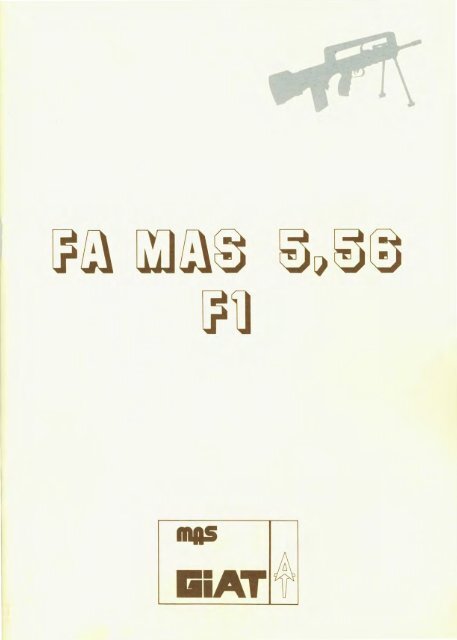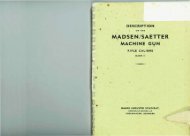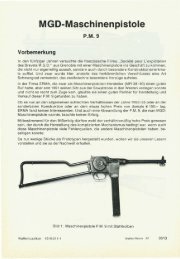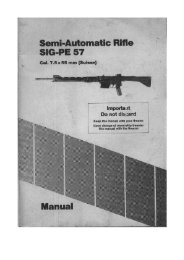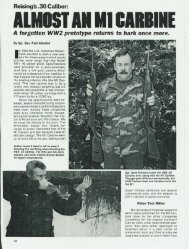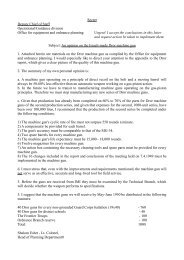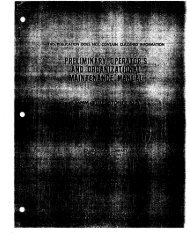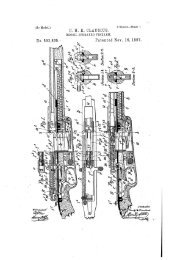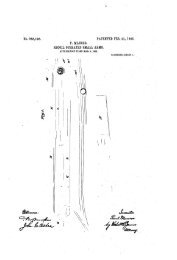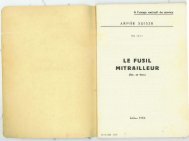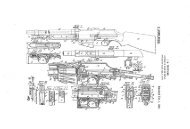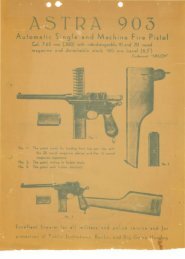FAMAS F1 manual - Forgotten Weapons
FAMAS F1 manual - Forgotten Weapons
FAMAS F1 manual - Forgotten Weapons
Create successful ePaper yourself
Turn your PDF publications into a flip-book with our unique Google optimized e-Paper software.
IIIAS<br />
liiiAT4
5.56 calibre auto111atic rifle<br />
111anufactured by the<br />
"Groupernent lndustriel<br />
des Arrnernents Terrestres,
TABLE OF CONTENTS<br />
Page<br />
Chapter I -General information. . . . . . . . . . . . . . . . . . . . . . . . 4<br />
Chapter II - Description and operation . . . . . . . . . . . . . . . . . . 8<br />
Chapter Ill- Use in normal conditions ................... 18<br />
Chapter IV- Use in special conditions ................... 26<br />
Chapter V -Jamming and trouble ...................... 27<br />
Chapter VI - Maintenance . . . . . . . . . . . . . . . . . . . . . . . . . . . . 29<br />
Chapter VII - Parts I ist. . . . . . . . . . . . . . . . . . . . . . . . . . . . . . . 35<br />
Chapter VIII -Table of compined unit components ........ 36
INTRODUCTION<br />
The FA-MAS 5.56-mm calibre rifle was designed and mass-produced by<br />
GIAT in its St. Etienne works (Manufacture Nationale d'Armes de St.<br />
Etienne). Since the end of 1979, it has been used by the French Army<br />
which has ordered several hundred thousand units. The rifle has been<br />
studied in great detail from the following standpoints:<br />
- ergonomics, with due consideration being given to the permanent<br />
requirements of the user : dimensions, we ight, transfer, ease of use and<br />
maintenance, etc.,<br />
- reliability and operating safety under the most difficult conditions<br />
of use,<br />
- operation of the rifle with all types of 5.56 mm ammunition currently<br />
in service (US, NATO),<br />
- efficiency of its multiple functions : precision firing of single shots,<br />
excellent stability and high power when firing in bursts (80 HP), grenade<br />
firing, (anti-tank, anti-personnel) ,<br />
- general quality of manufacture, with systematic monitoring of raw<br />
materials, the fabrication processes and firing performance of the rifle.<br />
Apart from the additional equipment supplied : bipod, bayonet attachment,<br />
cleaning accessories, etc. , the FA-MAS can also be proposed with<br />
training systems such as a sleeve for firing blank ammunition, or the<br />
Balplast reduced size firing system.<br />
3
1 - GENERAL INFORMATION<br />
1-1 - Presentation of the equipment<br />
1-1-1 - Function<br />
The FA-MAS calibre 5.56 is an automatic individual weapon designed<br />
for:<br />
- Bullet firing with single shot fire, complete bursts or limited bursts<br />
according to the position of the firing selector.<br />
- A.T., 500 g. grenade firing by means of a sighting rule incorporated<br />
in the protective handle.<br />
- A.P., 500 g. grenade firing :<br />
- Curved fire : buttstock placed on the ground, weapon inclined<br />
at 45° or 75° , aiming obtained by means of a vertical fire sighting<br />
rule fixed on to the protective handle.<br />
- Direct firing :the same as A.T. firing.<br />
1-1-2- Ammunition<br />
- 5.56 mm cartridges 0 and T in conformity with NATO standards.<br />
-With the 12" twist barrel, the FA-MAS can fire both French ammunition<br />
(<strong>F1</strong> and PPA) and American M193 ammunition. With a 9" twist<br />
barrel the FA-MAS can fire French, Belgian SS 109, and M193 ammunition.<br />
- 5.56 bulletless cartridges for 22 mm fin-stabilized rifle grenades.<br />
- 5.56 blank cartridges using a sleeve for firing blanks.<br />
- 5.56 "balplast" cartridges with speeial kit.<br />
1-2 - General description of the weapon<br />
The operating mechanism is an inertia amplifying mechanism.<br />
Empty cases are ejected to the right or to the left, according to the<br />
conformation of the firer.<br />
The line of sight, with single combat backsight, allowsaiming adjustment<br />
for elevation and direction - there is also a retractable slide<br />
fitted with luminescent spot for night firing.<br />
The entirely armoured plastic fittings ensure:<br />
- Protection of the vital parts of the weapon including the sighting<br />
parts.<br />
- Effective grasp for firing and carrying the weapon.<br />
- Protection of the user against firing heat.
1-4 - Performa nee<br />
Muzzle velocity of the ammunition Vo : 960 m/ s<br />
Rate of fire : 1000 shots/ min.<br />
H + L at 200 metres < 400 mm on a series of 10 cartridges.<br />
H + L at 300 metres < 600 mm on a series of 10 cartridges<br />
1-5- Operating limits<br />
1-5-1 -Temperatures<br />
1-5-1-1 - Extreme storage temperature<br />
- 54°C<br />
+ 71 ° C<br />
1-5-1-2- Extreme operating temperatures<br />
- Fo r bu llet f iring<br />
- For grenade firing<br />
1-5-2 - Barrel wear<br />
- 31.5°C<br />
+ 51.5°C<br />
Avoid firing more than four full magazines ( 100 shots) without letting<br />
the barrel cool down.<br />
Barrel resistance : 10 000 shots, 420 grenades.<br />
1-5-3 - Range limits<br />
- Bullet firing<br />
Single combat backsight from 0 to 300 metres.<br />
- Grenade firing<br />
Anti-tank firing: effective combat range= 75 to 100m<br />
Flat trajectory firing : A.P. (anti-personnel) effective combat range=<br />
100m<br />
Vertical firing A.P. at 45°<br />
1-5-4 - Perforations<br />
1-5-4-1 - Ammunitions<br />
90% perforation<br />
3.5 mm mild<br />
Ammunitions steel plate<br />
<strong>F1</strong> 355m<br />
PPA 584m<br />
55109 625 m<br />
(9 ins)<br />
1-5-4-2 -Grenades<br />
min : 140m<br />
max: 360m<br />
min : 70 m<br />
max: 180m<br />
AT 58 anti-tank grenades (80% probability)<br />
7 mm<br />
armour plate<br />
100m<br />
210m<br />
180m<br />
- 250 mm of armour plating at oo incidence<br />
- 130 mm of armour plating at 600 incidence<br />
AP-AV model <strong>F1</strong><br />
- 100 mm of armour plating at oo incidence<br />
15 mm light<br />
alloy plate<br />
140m<br />
326m<br />
273m
4 -The magazine fitted by means of a hook fixed to the front of the<br />
magazine casing.<br />
5-The protective handle which is fixed to the outer tube sub-assembly<br />
by centring on the main spring rod fixture nut and by pinning to the<br />
ringsight unit.<br />
2-1-1-1- The outer tube sub-assembly<br />
This sub-assembly is screwed on to the barrel and incorporates :<br />
- The cocking system fitted by fastening to the main spring guide<br />
rod.<br />
- The stock fitted, by centring on the stock spacer on the forward<br />
hoop of the outer tube.<br />
- The ringsight unit, fitted by means of the ringsight unit screw, spring,<br />
pointer and elevation screw ; these 4 parts are provided for adjusting<br />
the line of sight elevation.<br />
2-1-1 -2 -The cocking mechanism<br />
The mechanism comprises :<br />
- The cocking lever which closes the mobile assembly on to the cocking<br />
lever stop.<br />
-The spring tube, sealed and lubricated for life, which contains the<br />
main spring and ensures the connection between the cocking lever and<br />
the mobile assembly.<br />
2-1-1-3- The stock<br />
The stock is fitted on to the breech casing by crimping a cylindrical<br />
liner and on to the outer tube sub-assembly by centring the stock<br />
spacer on the forward hoop of the outer tube.<br />
The stock incorporates :<br />
- The selector plate for trigger guard adjustment.<br />
-The trigger and firing selector: single shot, burst, safety.<br />
- The trigger guard arch.<br />
- The pistol grip which is hollow and closed at the bottom by a hinged<br />
cover, so that it can be used to contain cleaning (oiler) or spare<br />
parts.<br />
9
2-1-1-4- The f oresight support<br />
This part is fitted to the barrel by pinning<br />
and incorporates:<br />
- The foresight consisting of a spring blade<br />
which allows line of sight direction adjustment.<br />
- The retractable slide with luminescent spot<br />
for night firing.<br />
2-1-1-5- The grenade inserting ring<br />
- This part allows variation of the muzzle velocity of rifle grenades<br />
with a flash suppressor sleeve with an external diameter of 22 mm.<br />
(curved firing).<br />
- At maximum insertion, it enables rear centring of the bayonet.<br />
2-1-2- The bolt<br />
The bolt comprises :<br />
- The added mass which enables hooking of the bolt to the spring tube<br />
through a sliding pin fixed to the latter part.<br />
- The breech bolt with central ejector, designed for ejection to the right<br />
or to the left by reversing the extractor and the plug after dismantling<br />
the bolt.<br />
- The firing pin.<br />
- The delayed blow-back lever.<br />
1n
2-1-6 - The magazines<br />
The weapon takes a 25 bullet cartridge magazine<br />
and a single propellent cartridge magazine<br />
(for firing grenades).<br />
The 25 cartridge magazine has a steel frame, a<br />
shoe-plate, a follower spring and a plastic<br />
follower plate.<br />
2-1-7- The universal sling<br />
The sling is made of synthetic material, and comprises a long belt<br />
with a hooking device at one end and a short belt fitted with a mobile<br />
slide. The width of the sling may be adapted to the morphology of<br />
the user, and allows the weapon to be carried in several different<br />
ways: over the shoulder, on the back, on the stomach.<br />
2-1-8 - The bipod<br />
The bipod comprises two independent branches with plastic base,<br />
which are attached to the art iculations fitted to the protective handle.<br />
It has two positions :<br />
-transport<br />
- utilisation<br />
l J j
2-2-3-3 - Automatic operating mode<br />
This is identical to the single shot operating<br />
mode with regard to the first four paragraphs.<br />
Then, since the stroke of the sear drive (13)<br />
is longer in the burst position (diagram 8), the<br />
hammer can no longer hook on to the driven<br />
sear ( 11) and there is firing as soon as the<br />
automatic sear (5) is clear.<br />
Operation stops at the end of action on the<br />
trigger or when the magazine is empty.<br />
2-2-4- Operation in the limited burst mode<br />
- When the limiter is engaged (position 3) and<br />
the finger is pressed on the trigger, on each<br />
backward rotation of the hammer, the hammer<br />
rod (3) causes rotation of the limiter operating<br />
lever (19), the driving-pawl (21) of which causes<br />
the ratchet wheel to make one turn corresponding<br />
to the counting of one shot (diagram 9).<br />
A retaining catch (20) then engages in the opposite<br />
wheel and prevents the ratchet wheel from<br />
returning to its original position (diagram 10).<br />
One shot is counted.<br />
- When the hammer performs its stroke to strike<br />
the firing pin, its rod frees the operating lever,<br />
which returns to its original position supported<br />
on the hub of the ratchet wheel (diagram 11).<br />
- Counting ofthe following two shots is effected<br />
in this way, and operation of the trigger mechanism<br />
during the first two shots is identical to<br />
operation in the automatic mode.<br />
- At the third shot, the limiter catch (22) stops<br />
the hammer at the end of its backward movement,<br />
hooking it on to the lower catch of the<br />
hammer (4) (diagram 12/. This hooking is effected<br />
by rotation of the ratchet wheel cam,<br />
which on the third shot causes pivoting of the<br />
limiter catch.<br />
Firing is interrupted, and it is the release of<br />
finger pressure on the trigger (28) which releases<br />
the limiter catch in two stages :<br />
1 - Release of the driving-pawl (21) and retaining<br />
catch (20) by rotation of the uncogging<br />
part (23), the latter rotation being actuated<br />
by the backward movement of the connecting<br />
rod (diagram 13).<br />
2 - Return of the ratchet wheel ( 18) to its original<br />
position under the action of its spring<br />
which, by rotation of the cam, also effects the<br />
return of the limiter catch to its normal position<br />
(diagram 13).<br />
The hammer can then catch on to the driven<br />
sear ( 11).<br />
5 11<br />
21 20 18 23 22<br />
3 4<br />
19 20 21 18 22<br />
19 3<br />
22 4<br />
22 21 18 29 22<br />
Diagram 8<br />
Diagram 9<br />
Diagram 10<br />
Diagram 11<br />
Diagram 12<br />
Diagram 13
3- USE IN NORMAL CONDITIONS<br />
3-1 -Preliminary operations and checks<br />
See paragraph 1-6 : Safety instructions concerning the equipment<br />
before firing. In particular, make sure:<br />
- for ball cartridge firing, that the cheek rest is on the opposite side<br />
to ejection.<br />
-for firing A.P. grenades, that the weapon is positioned in such a<br />
manner that spent cartridges are ejected towards the ground.<br />
- For optimum operational regularity, even under prolonged firing<br />
conditions, that the quantity of lubricant on the moving parts and<br />
trigger mechanism does not exceed the film value required for adequate<br />
protection from corrosion.<br />
N.B. : Under special conditions of sand or dust storms in desert areas,<br />
the rifle must be dry before firing.<br />
3-2 -Operating methods and checks<br />
3-2-1 - Ball cartridge firing<br />
3-2-1-1 - Use of magazine<br />
- Loading a magazine :<br />
Two cases:<br />
1 -Cartridges supplied in bulk.<br />
Insert the cartridges by pressing them one by one into the magazine,<br />
making sure to place the cartridge base at the end with the two small<br />
rear ribs.<br />
2- Cartridges supplied on loading clip<br />
Place the loader supplied with cartridges on the magazine. Fit the<br />
loading clip to the loader.<br />
Insert the series of cartridges by pressing the row of cartridges, with<br />
the thumb.<br />
- Unloading a magazine<br />
Expel the first cartridge towards the front by pressing the base of the<br />
cartridge using the base of another cartridge.<br />
3-2-1-2- Inserting the magazine<br />
- Place the weapon in the safety position (S mark on the firing selector).<br />
- Insert the magazine at an angle in order to engage the rear part of<br />
the lips of the magazine casing first of all, and tip the lower part of the<br />
magazine towards the front thereby pushing it into the casing until it<br />
clicks into place.<br />
3-2-1-3- Removing the magazine<br />
- Place the weapon in the safety position (S mark).<br />
- Press the magazine hook and pull the magazine downwards by<br />
tilling it slightly towards the rear of the weapon.<br />
- If applicable, remove any cartridge that may remain in the chamber<br />
by <strong>manual</strong> cocking.<br />
1R<br />
'f
- For prec1s1on firing, the finger pressure control on the trigger IS<br />
facilitated bv a small boss.<br />
Firing in three-shot bursts<br />
- Firing selector on position R. Limited burst selector on position 3.<br />
- Pull the trigger.<br />
- It is very important to pull the trigger home AS FAR AS POSSIBLE<br />
and to hold it in this position. If trigger travel is limited, the rifle<br />
acts as if it were in single shot firing mode. In such cases, it is possible<br />
that bursts of only two shots, or even a single shot, will be obtained.<br />
- In all cases, the following burst will include three shots if, as speci <br />
fied, the trigger is maintained fully pulled, as the burst selector returns<br />
to its initial position as soon as the trigger is released.<br />
In automatic firing<br />
- Firing selector on position R. Limited burst selector on position 0 .<br />
- Pull the trigger home completely.<br />
- It is important to maintain the trigger pulled home for as long as the<br />
burst of firing is to be continued.<br />
- To interrupt a burst, simply release the trigger.<br />
3-2-2 - Firing of blank cartridges<br />
The rifle can be used for firing blank cartridges by screwing a blank<br />
firing sleeve to a shutter against the front end of the barrel supported<br />
on the rear part of the flash-suppressor. The rifle can then be<br />
fired under exactly the same conditions as ball cartridge firing : in<br />
single shots, in short bursts of three shots or in long bursts.<br />
IMPORTANT:<br />
- Check that the sleeve is always well<br />
screwed on.<br />
- THE USER MUST UNDER NO CIR <br />
CUMSTANCES USE THE WEAPON THUS<br />
EQUIPPED WITH ORDINARY CARTRID<br />
GES OR GRENADE-LAUNCHING CAR<br />
TRIDGES.<br />
20<br />
---<br />
·-<br />
\
3-2-3 - Using the bipod<br />
Deployment of the bipod<br />
- Take one leg of the bipod and pull it towards the rear of the rifle<br />
until it can swivel .freely around its joint.<br />
- Swivel the leg forwards until it clicks into the notch of the required<br />
position.<br />
- Repeat this operation for the second leg.<br />
Folding away of bipod<br />
- Give a sharp knock on each leg, which then automatically returns<br />
to the transport position.<br />
3-2-4 - Grenade firing<br />
3-2-4-1 -Types of grenade<br />
The FA-MAS 5.56 F 1 can fire all types of 500 g grenades with a fin<br />
diameter of 22 mm.<br />
For example : - anti-tank (AT) grenades,<br />
- anti-personnel (AP) grenades,<br />
- anti-personnel, anti-vehicle (AP-AV) grenades.<br />
- smoke grenades,<br />
- lighting grenades,<br />
- practice grenades with passive head.<br />
3-2-4-2 - Firing methods<br />
The FA-MAS is equipped with two sighting systems for grenade firing :<br />
a) For indirect firing, a twin position sighting rule (45° or 75° ) :<br />
at 45° the effective combat range is between 140 and 360 metres<br />
at 75° , the effective combat range is between 70 and 180 metres.<br />
b) For direct firing, a sight notch sighting rule that is aligned with<br />
the fore sight. There are two positions for firing at ranges of 75 and<br />
100 metres. Yellow-orange luminescent spots are available for night<br />
firing.<br />
3-2-4-3 - Magazine for propellent cartridges<br />
The rifle can take a special magazine for firing propellent cartridges.<br />
The magazine holds only one propellent cartridge.<br />
Magazines are inserted and removed in the same way as for firing ball<br />
cartridges.<br />
NB : Certain grenades are provided with a bullet trap and the use of<br />
propellent cartridges is not necessary : with grenades of this type, ball<br />
cartridges can be fired immediately after firing a grenade without<br />
any further manipulation.<br />
3-2-4-4- Preparing the weapon for grenade firing<br />
1 -Place the rifle in the safety position.<br />
2- Select the firing system :direct firing or indirect firing.<br />
21
3-2-4-5- Indirect firing<br />
- Place the grenade inserting ring on the selected<br />
mark corresponding to the distance to be fired.<br />
- Orient the anti-personnel sighting rule (see<br />
photo) according to the angle selected (45° or<br />
75° ).<br />
- Push the grenade home on the inserting ring<br />
until the stop is reached.<br />
- Pull out the grenade safety pin.<br />
- Load the magazine with a propellent cartridge.<br />
- Take up the firing position, rifle butt on<br />
ground, ejection side turned towards the ground.<br />
- Place the firing selector in the position 1<br />
(single shot firing).<br />
- Cock the rifle, aim and fire.<br />
The rifle can be fired in either the prone or the<br />
standing position, with the butt firmly supported.<br />
3-2-4-6- Direct firing<br />
- Place the grenade inserting ring in maximum position.<br />
- Raise the sighting rule in the hand guard casing by pivoting it<br />
forwards.<br />
- Select the firing distance<br />
Movable carrier in low position :<br />
Movable carrier in high position :<br />
range of 75 metres<br />
range of 100 metres<br />
- Push the grenade home on the inserting ring until the stop is reached<br />
by slightly pivoting the grenade.<br />
- Pull out the grenade safety pin.<br />
- Load the magazine :<br />
a- either special magazine with its propellent cartridge<br />
b- or normal magazine with ball cartridges in the event of grenades<br />
with built-in bullet trap.<br />
-Take up firing position holding the rifle firmly against the body.<br />
- Place the firing selector on position 1 for single shot firing.<br />
- Cock the rifle.<br />
- Aim by aligning the target, the sight holder and the sight notch.<br />
-Fire.
,I<br />
3-2-4-6-1<br />
Standing position (see photograph)<br />
Hold the rifle firmly by the pistol grip and<br />
butt, holding it against the body.<br />
For a right-handed person, the right hand<br />
should hold the pistol grip and the left hand<br />
the butt, the rifle being pressed against the<br />
right shoulder.<br />
The position is reversed for a left-handed<br />
person.<br />
3-2-4-6-2<br />
Prone position (see photograph)<br />
The rifle is held in exactly the same way as<br />
in the standing position.<br />
In the prone position, the rifle is supported<br />
on the bipod but the firer must be holding<br />
it firmly against the body.<br />
3-2-4-6-3<br />
Kneeling position (see photograph)<br />
Hold the rifle in-the same manner as described<br />
for standing position.<br />
23
3-2-5- Aiming for grenade firing<br />
3-2-5-1 - Direct firing in daylight<br />
T he line of sight materialised with t he retractable sight ing rule must<br />
pass t hrough the f our f ollowing points:<br />
1 -The eye of the firer<br />
2 - The square not ch sight, of t he raised sig hting rule.<br />
3 - The normal frontsight.<br />
4- Target_<br />
3-2-5-2- Direct firing at night<br />
The line of sight is in this case materialised on the raised sighting rule<br />
by two yellow-orange luminescent spots and on the deployed slide<br />
by a green luminescent spot.<br />
3-2-5-3- Indirect firing (daylight only)<br />
Identical to direct firing for 1, 2 and 4; for 3 :top of frontsight holder.<br />
3-2-6- Use of the sling<br />
1 - The hooking device of the long belt is placed on its hooking point<br />
located on the bipod drum, by successive half-turns.<br />
2- Insert the long belt in the metal buckle with beaks of the small<br />
belt (beaks upside down).<br />
3- Fold over the long belt after threading it through the stock loop<br />
and insert in the quick tightening device then through the loop.<br />
')II
Use of "shoulder slung weapons"<br />
- Hook on the metal buckle by means of its beaks to the hooking<br />
ring as indicated in the photograph.<br />
" Combat" use<br />
- Unhook the metal buckle with beak from the hooking ring .<br />
- The metal buckle then slides along the long belt.<br />
- Place the weapon slung across the chest.<br />
- From this position it is possible to take aim quickly.<br />
25
4- USE IN SPECIAL CONDITIONS<br />
- cf. paragraph 1-5 operating limits (page 6)<br />
4-1 - Very low temperatures and NBC environment<br />
Use of the trigger guard arch<br />
- Pull on the part of the arch located on a level<br />
with the pistol grip so as to release it from<br />
its normal operating position.<br />
- Turn through 1800 to set it for use at very<br />
low temperatures or NBC environment.<br />
Use a lubricant compatible with the operating<br />
temperature. If not, clean and lubricate with<br />
paraffine oil only.<br />
4-2 - Precautions to be taken during movements when water is likely<br />
to enter the barrel (rain, weapon dropped into water, etc.)<br />
- Take the precautions mentioned under section 1-6-2, second paragraph .<br />
4-3- Sand and dust<br />
Reduce lubrication to the minimum.<br />
4-4- Bullet firing at night<br />
See para . 3-2-1-6.<br />
4-5- Direct firing of grenades at night<br />
See para. 3-2-5-2.
5-1- Jamming<br />
5- JAMMING AND TROUBLE<br />
Possible jamming and trouble generally fall into one of the following<br />
three categories :<br />
1 - Trouble resulting from excessive fouling of the weapon due to<br />
negligence by the user or his lack of knowledge of the weapon.<br />
2 - Trouble caused by accidental mechanical failure of the weapon .<br />
3 - Trouble caused by using the weapon in unfavourable conditions<br />
(snow, sand, mud ... ).<br />
Jamming or interruption of firing, unless caused by an empty magazine<br />
or failure of a part, is generally quickly eliminated without looking for<br />
the cause of the trouble.<br />
- If there is incomplete closure, press on the base of the cocking lever<br />
so as to make sure that the lever closes on to the cocking lever stop,<br />
then resume firing. If slight pressure is insufficient to close the coking<br />
lever, ensure that there is no foreign body fouling the barrel or firing<br />
mechanism.<br />
- If there is insufficient recoil, cock to eject the case of the fired<br />
cartridge and insert another cartridge, then resume firing.<br />
- In the case of any other firing trouble :<br />
- Keep the weapon in firing position.<br />
- Remove the magazine.<br />
- Cock twice.<br />
- Remove the case remaining inside the weapon (if applicable).<br />
- Insert magazine- cock, then resume firing.<br />
Should the trouble occur again : remove the magazine, replace it by<br />
another, then resume firing. If the trouble persists, consult the gunsmith<br />
or instructor to determine what is wt:ong.<br />
NB : if the shot does not take place after firing, wait at least 10 seconds<br />
before opening the breech so as to avoid the consequences of possible<br />
delayed firing.<br />
?7
5-2 -Troubles<br />
No percussion<br />
No extraction<br />
Possible troubles<br />
Resistance felt when inserting magazine<br />
Incorrect position of cartridge<br />
In single shot position departure in bursts<br />
Cartridge case not ejected<br />
Causes<br />
Incomplete closure<br />
Firing pin broken<br />
Extractor deteriorated<br />
Chamber fouled<br />
Weapon fouled<br />
Magazine warped<br />
Magazine warped<br />
Follower plate warped<br />
Trigger-guard badly adjusted<br />
Ejector spring too weak<br />
Extractor spring too weak<br />
Remedies<br />
Cock and make sure<br />
of closure before firing<br />
Change firing pin<br />
Change extractor<br />
Clean weapon and<br />
clean chamber (rifling)<br />
Clean weapon<br />
Change magazine<br />
Change magazine<br />
Adjust trigger-guard<br />
Change ejector-spring assembly<br />
Change extractor-spring assembly<br />
Delayed firing Defective cartridge Check to ensure bullet is not still in barrel<br />
Grenade not retained<br />
?R<br />
Changing parts: see chapter on dismantling.<br />
To replace the grenade brake spring :<br />
Brake spring lost<br />
- Close the inserting ring up towards the flash-suppressor.<br />
- Roll a sheet of heavy paper round these two parts, engage the<br />
brake spring on to the cylinder thus formed and make it slide up<br />
to its housing on the ring.<br />
Replace the grenade brake spring
6-1 - Dismantling<br />
reassembly.<br />
6-1-1 - Remove the stock<br />
6- MAINTENANCE<br />
for maintenance and<br />
- If the strap is tight, slacken it as would normally<br />
be the case for carrying the weapon over<br />
the shoulder.<br />
- Expel the stock assembly stud, and place it<br />
in the tubular casing for fixing the stock to the<br />
breech casing.<br />
- Pull the stock backwards.<br />
- In order to dismantle the cheek rest, push the<br />
top of this part so that by elastic deformation it<br />
can be removed from the stock.<br />
6-1-2 - Remove the protective handle.<br />
- Expel the assembly stud of the protective<br />
handle a.nd place it in the tubular casing fitted<br />
to the ringsight support.<br />
- Push the protective handle towards the foresight,<br />
removing it from the sighting line by<br />
pulling it upwards.<br />
6-1-3 - Remove the mechanism unit<br />
- Push the mechanism unit assembly stud with<br />
the tip of a bullet or one of the two stock studs<br />
or protective handle studs and pull it so as to<br />
bring it into contact with the breech casing<br />
safety catch.<br />
- Remove the mechanism unit by rotating it<br />
round the rear support of the breech case.<br />
29
6-1-4 - Remo ve the mobile assembly<br />
- Pull back the mobile assembly until the cocking lever makes contact<br />
with the rear face of the cocking lever stop.<br />
- Free the mobile assembly from the spring tube by pushing the assembly<br />
stud as under para. 6-1-3.<br />
- Pull the mobile assembly backwards, allowing it to slide freely in the<br />
T groove of the breech casing.<br />
6-1-5 - Disassembly of the bolt<br />
- Separate the mobile breech assembly, the<br />
inertia amplifying lever and the firing pin from<br />
the added mass by making it slide along the bottom<br />
of the latter part until the lever is in the<br />
vertical position. In this position the slide on<br />
the head of the breech is freed from the corresponding<br />
part of the added mass, and the<br />
two parts can be separated by pulling on them.<br />
Dismantle the amplifying lever by making<br />
it turn around its axis until its upper wings<br />
are in line with the breech and remove it from<br />
its housing in this position.<br />
Pull the firing pin backwards.<br />
6-1-6 - Dismantling the removable head<br />
- Using the base of a case or the head of one of the stock assembly<br />
studs or protective handle studs, raise the support finger of the removable<br />
head.<br />
- Engage the base of the case or the head of one of the stock assembly<br />
studs or protective handle studs under the extractor claw and pull<br />
the removable head.<br />
- After dismantling in this way, there are 6 parts or assemblies :<br />
-The breech<br />
- The removable head<br />
- The support finger<br />
- The ejector, its spring and its inside rod<br />
- The extractor and its spring<br />
-The plug.<br />
In order to reverse the ejection, simply exchange the extractor a nd its<br />
spring with the plug.<br />
)
6-1-7- Dismantling the bipod<br />
To dismantle the bipod proceed in the same way as for mounting it<br />
(section 3-2-3), but continue to rotate the arms 120° beyond their<br />
normal position in use and in that position remove them laterally from<br />
their articulations.<br />
6-1-8- Reassembly<br />
Reassembly is carried out in the reverse order of dismantling, although<br />
the following precautions must be taken :<br />
- Reassembly of the removable head :<br />
Before reassembling the ejector make sure that the inside rod is exectly<br />
in place (photo page 30) .<br />
- Use the spring ejector assembly to centre the removable head<br />
so as to be able to fit the support finger without any difficulty.<br />
- Push the removing head with the firing pin.<br />
- Fit the support finger, paying attention to the direction of<br />
assembly : the groove in which the base of the case is engaged<br />
(section 6-1-6) must be outside the breech after assembly.<br />
- Reassembly of the mobile assembly :<br />
First of all, assemble the firing pin and align the rear notch of the<br />
amplifying lever passage with the breech bore before reassembling<br />
the lever.<br />
Before reassembling the added mass make sure that the two supporting<br />
parts of the amplifying lever on the added mass are opposite the<br />
heel of the mobile breech.<br />
Before assembling the mobile assembly on the breech casing make<br />
sure that the slideway located on top of the breech is effectively<br />
engaged in the corresponding part of the added mass.<br />
- Reassembly of the mobile assembly on the breech casing :<br />
Hold the mobile assembly in the open position and slide it freely,<br />
without forcing, in the slideway of the breech casing.<br />
- Reassembly of the mechanism unit : before reassembling the mechanism<br />
unit make sure that the hammer is hooked on to the automatic<br />
sear and that the connecting rod is in the rear position.<br />
Engage the rear part of the mechanism unit into the corresponding<br />
housing of the breech casing by inclining it slightly (photo page 29),<br />
pivot it around this hooking point and pin it.<br />
31
6-2-2-1 - Cleaning the barrel and chamber<br />
The barrel is cleaned with a cleaning rod used with a square cloth of<br />
dimensions (6 x 6 em of fine cloth) such that if forces slightly in the<br />
barrel. The cleaning cloth must be removed from the barrel after<br />
each return stroke. Introduce the cleaning rod by the barrel mouth<br />
piece so that the patch does not catch in the ring grooves.<br />
After a few strokes effected with a dry, clean cloth, the internal<br />
surface of the barrel must be smooth and shiny. Otherwise, continue<br />
cleaning with an oil-soaked cloth.<br />
The chamber must be cleaned with a metal brush; use an oil-soaked<br />
cloth to remove any matter fouling the chamber.<br />
6-2-2-2 - Cleaning of other metal parts<br />
Other parts must be cleaned with a dry, clean cloth or w ith paraffin<br />
oil if the parts are very dirty.<br />
If rust patches show up, soak them in oil for a moment, then rub with<br />
an oil-soaked cloth.<br />
6-2-2-3 - Cleaning of plastic parts<br />
Clean with a moist clean cloth.<br />
6-2-2-4- Cleaning the mechanism unit<br />
If metal debris or non-burnt products have entered the mechanism<br />
unit, clean the trigger mechanism and bu rst limiter with a fine brush.<br />
6-2-3 - Checking<br />
Each cleaning should be an occasion for checking the condition of the<br />
various parts of the weapon, and to show up incipient cracks, unusual<br />
wear and other deformations as well as breakage : in particular, the firing<br />
pin and the amplifying lever.<br />
6-2-4 - Protection<br />
Once the weapon is cleaned and its condition checked, it is necessary,<br />
before reassembly, to give it a protection against rust.<br />
All the metal parts should be lightly oiled after cleaning. The barrel is<br />
protected by giving one backward and one forward stroke with an oilsoaked<br />
cloth which should be clean.<br />
6-3 - Adjusting the line of sight<br />
See MAT 1057 (technical guidance leaflet<br />
supplied with rifle ) for dismantling of the<br />
protective handle.<br />
6-3-1 - Adjustment for elevation<br />
- The line of sight is adjusted for elevation by<br />
moving the ringsight unit as follows. Lower the<br />
adjustment wheel index and then compress<br />
the ringsight spring by means of the screw.<br />
To facilitate this operation, a cartridge case<br />
can be removed to compress the spring.<br />
- If the rifle fires high : tighten the bolt and<br />
the ringsight is lowered.<br />
- If the rifle fires low : unscrew the bolt and<br />
the ringsight rises.<br />
- Shift value : one rotation of a bolt notch<br />
leads to an average point variation of about<br />
6 em at a distance of 200 metres (0.30 r;ri ) •<br />
33
6-3-2- Adjustment for direction<br />
- Direction is adjusted by compressing or releasing a spring blade by<br />
means of a serrated nut.<br />
- If firing is to the left :screw off.<br />
- If firing is to the right : screw on.<br />
- Value of the shift : the passage from one notch to another causes<br />
a variation in the mean centre point of about 6 em at 200m (0.30 m).<br />
14
7 - PARTS LIST<br />
Description of the parts itemised on the various diagrams<br />
Hammer stop<br />
2 Percussion spring<br />
3 Percussion rod<br />
4 Hammer<br />
5 Automatic sear<br />
6 Sear spring guide rod<br />
7 Automatic sear control<br />
8 Mechanism unit<br />
9 Breech casing<br />
10 Inertia amplifying lever<br />
11 Driven sear<br />
12 Driven sear notch<br />
13 Driven sear drive<br />
14 Connecting rod<br />
15 Forward stud of connecting rod<br />
16 Rear stud of connecting rod<br />
17 Fire selector<br />
18 Ratchet wheel<br />
19 Limiter operating lever<br />
20 Retaining catch<br />
21 Driving-pawl<br />
22 Limiter catch<br />
23 Uncogging part<br />
24 Disengaging trolley<br />
25 Burst limiter switch<br />
26 Uncogging spring pin<br />
27 Connecting rod return spring<br />
28 Trigger<br />
29 Ratchet wheel stop pin<br />
35
8 ·TABLE OF COMPINED UNIT COMPONENTS<br />
PART NAME Oty<br />
5.56 assault rifle, model <strong>F1</strong>......... . .. . ........ 1<br />
ACCESSORIES<br />
Magazine . ...... . .......................... 6<br />
Magazine for one protellent cartridge . . . . . . . . . . . . . 1<br />
Bayonet with sheath . . . . . . . . . . . . . . . . . . . . . . . . . . 1<br />
Sling..... . .. . . . . .. . . ... . . .. .. . ........... 1<br />
Removable rod . . . . . . . . . . . . . . . . . . . . . . . . . . . . . . 1<br />
Cleaning rod . . . . . . . . . . . . . . . . . . . . . . . . . . . . . . . 1<br />
Chamber cleaning brush . . . . . . . . . . . . . . . . . . . . . . . 1<br />
Brass cleaning brush . . . . . . . . . . . . . . . . . . . . . . . . . . 1<br />
Nylon cleaning brush. . . . . . . . . . . . . . . . . . . . . . . . . . 1<br />
Oil can. . . . . . . . . . . . . . . . . . . . . . . . . . . . . . . . . . . . . 1<br />
Synthetic cloth bag for FA 5.56 F 1 accessories. . . . . . 1<br />
Synthetic cloth magazine holder for FA 5.56 F 1 . . . 2<br />
Technical guidance leaflet MAT 1057. . . . . . . . . . . . . 1<br />
SPARE PARTS<br />
Support finger . . . . . . . . . . . . . . . . . . . . . . . . . . . . . . 1<br />
Complete ejector . . . . . . . . . . . . . . . . . . . . . . . . . . . . . 1<br />
Extractor w ith spring . . . . . . . . . . . . . . . . . . . . . . . . . 1<br />
Cover. . . . . . . . . . . . . . . . . . . . . . . . . . . . . . . . . . . . . . 1


